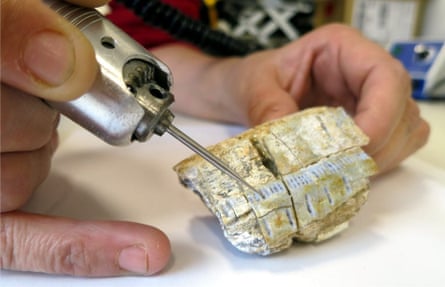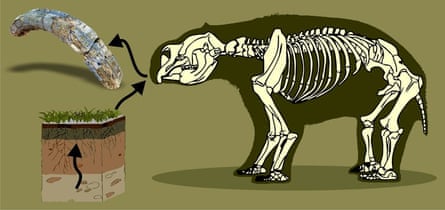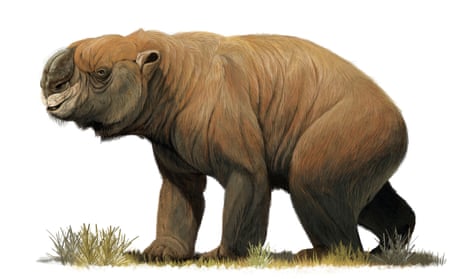Perhaps nowhere is the debate regarding the causes of megafaunal extinction more prominent than in Australia. During the Pliocene and Pleistocene epochs, a magnificent suite of giant marsupials (mammals who carry their young in a pouch), reptiles and birds roamed Australia, only to meet their demise at the end of the Pleistocene. Why these behemoths disappeared has been, and continues to be, the subject of extensive discussions.
Much of the debate revolves around the timings of megafaunal extinctions, the arrival and spread of modern humans in Australia, and the role of climate change. However, as reliable dates for many of the extinct species are lacking and the arrival of modern humans in Australia keeps getting pushed back in time, the debate remains far from being resolved. Therefore, some scientists argue that if we want to know what really happened, we need to step away from the dating game, and start looking more into biological and ecological variables that contributed to the megafaunal demise.
If there is one animal that can be considered as the icon of Australia’s marvellous extinct megafauna, it must be Diprotodon. With a shoulder height of 1.7 meters, and weighing close to a whopping three tons, this behemoth was the largest marsupial ever to have lived. As such, these massive herbivores were likely to have been important players in the Australian ecosystem. The first species of fossil mammal described from Australia (by Richard Owen, he of the dinosaurs, in 1838), Diprotodon fossils have been found throughout the continent.
Diprotodon was only one species of a superfamily of megamarsupials, the Diprotodontoidae who ruled Australia for nearly 24m years. All of them went extinct in the Pleistocene, but some argue that Diprotodon may have persisted until 25,000 years ago, well after humans arrived on the continent.

Paleontologist Gilbert Price, based at the University of Queensland, decided to subject a Diprotodon incisor to a range of geochemical analyses to gain a better understanding of this species life habits. During an animal’s life, chemical elements from its diet are incorporated in its bones and teeth. Ever-growing incisors, such as those in Diprotodon, can therefore be considered an archive of the individual’s life. Teeth are particularly well suited for such analyses, as they are less likely to be chemically altered after death (in contrast to bones, which are more susceptible to chemical components washing in or out, thereby altering the original biochemical composition).
One of the main techniques Price and his team used was stable isotope analyses. Isotopes are variants of the same chemical element but differ in the number of neutrons. Stable (non-radioactive) isotopes form after radioactive decay, and measuring the ratios of radioactive vs stable isotopes in biological tissue can reveal important biological information. For instance, the difference in 12C and 13C isotopes, expressed as δ13C, indicates the different carbon sources in the vegetation an organism fed on (different carbon pathways in so-called C3 and C4 plants result in different carbon signatures). Oxygen isotopes derive from water intake and reflect climatic changes (as the oxygen isotope ratio varies with the amount of rain). Strontium (Sr) is released from rocks during the weathering process, which then becomes incorporated in vegetation.

By sampling the Diprotodon incisor every 2mm along the entire length of the tooth, Price and his team acquired a good overview of the changes in stable isotope ratios of carbon, oxygen and strontium throughout this individual’s lifetime, and thus a track record of its dietary habits and movements. The incisor itself was dated to around 300,000 years ago. The δ13C values along the incisor suggest that the animal fed on a mix of grasses, shrubs and herbs. This is consistent with interpretations from morphological and micro-wear data, and confirmed by fossil evidence for the presence of extensive tropical rainforest in eastern Australia during the Middle Pleistocene.
What is most striking is that the strontium ratios fluctuate along the length of the tooth. Strontium reflects local geology: as different regions may have different local Sr isotope ratios, fluctuation of those ratios through an ever-growing tooth may reflect an organism eating its way through distinct geologic areas. The fluctuations in Sr ratios in Diprotodon thus reflect recurring movement of the animal through the landscape, and suggests that the individual traveled to the same geologic areas several times as the incisor grew. In living mammals this is called migration.
The Sr ratios in the sample fall within those reported for the Darling Downs region in central eastern Australia, where the fossil specimen was found, and indicate that the animal likely traveled about 200km annually. Outside of the area, Sr rations are much higher and lower, respectively. Had Diprotodon migrated outside this area, the Sr ratios from the incisor would have been different, depending on which area it had munched on.
No other marsupial, living or extinct, is known to migrate. Some species of kangaroos may wander nomadically, but modern marsupials were considered incapable of long-distance dispersal due to their generally smaller body size compared to their migrating placental cousins. However, the repetitive two-way migrations as reflected by the Sr signal in Diprotodon indicates that large-bodied marsupials did migrate.
So why did Diprotodon migrate? The δ13C ratio in this Diprotodon sample matches that seen in others (DeSantis et al., 2017), and together, the variation in δ13C in Diprotodon is less than in their closest living modern relatives, the wombats. This suggests that Diprotodon had a relatively strict diet or that there was less variation in available food. Alternatively, migration may have been a way for Diprotodon to keep eating its favourite food. However, as the warm, tropical Middle Pleistocene drew to a close, increasing aridity and habitat change may have been too much for Diprotodon to handle.
The evidence for annual migrations in Diprotodon is reminiscent of the annual large mammal migrations in Africa, and it leaves one to question if other extinct marsupials migrated as well. Price states that it would surprise him if there were no other ice age migrants in Australia. Potential migrants include other species of diprotodontoids such as marsupial “rhinos” and “tapirs”, as well as kangaroos. That leaves the question, when humans first arrived in Australia, did they stop and look in awe at the herds of behemoths moving at the horizon?
References
DeSantis, LRG., et al., 2017. Dietary responses of Sahul (Pleistocene Australia-New Guinea) megafauna to climate and environmental change. Paleobiology 43.
Price, G., et al., 2017. Seasonal migration of marsupial megafauna in Pleistocene Sahul (Australia–New Guinea). Proceedings of the Royal Society B 284

Comments (…)
Sign in or create your Guardian account to join the discussion